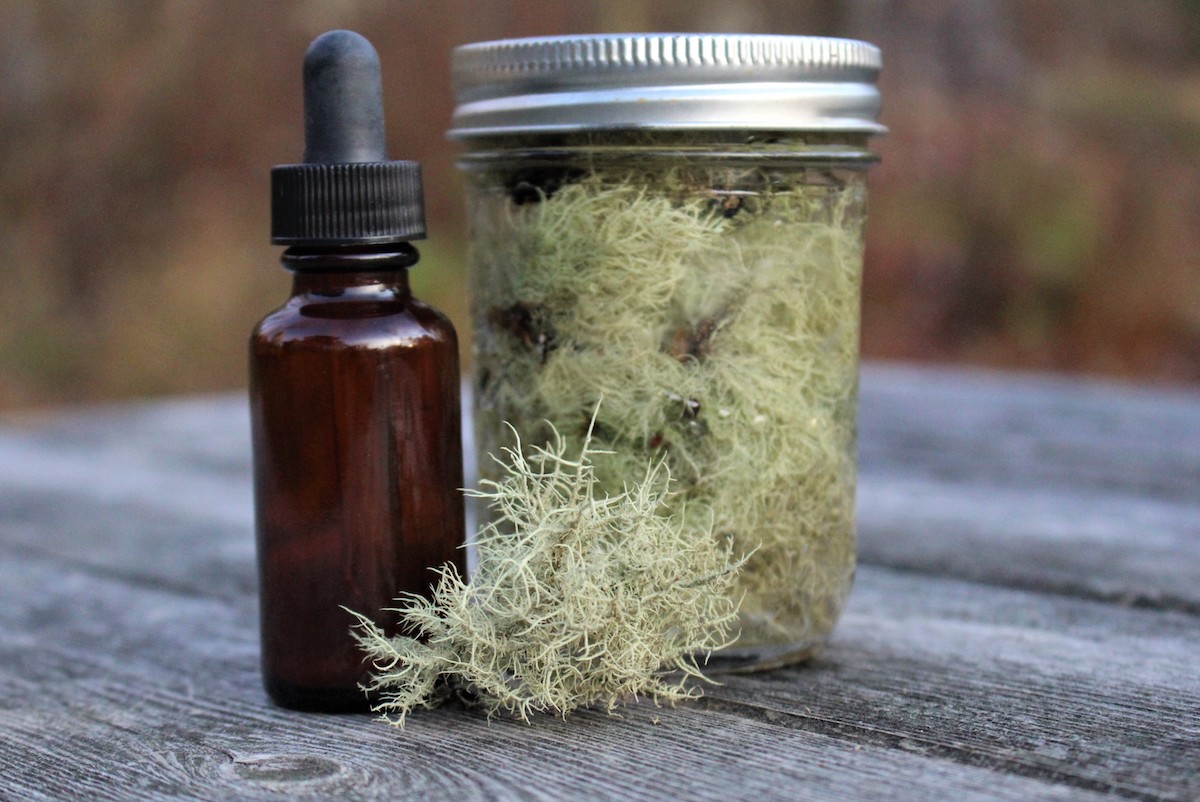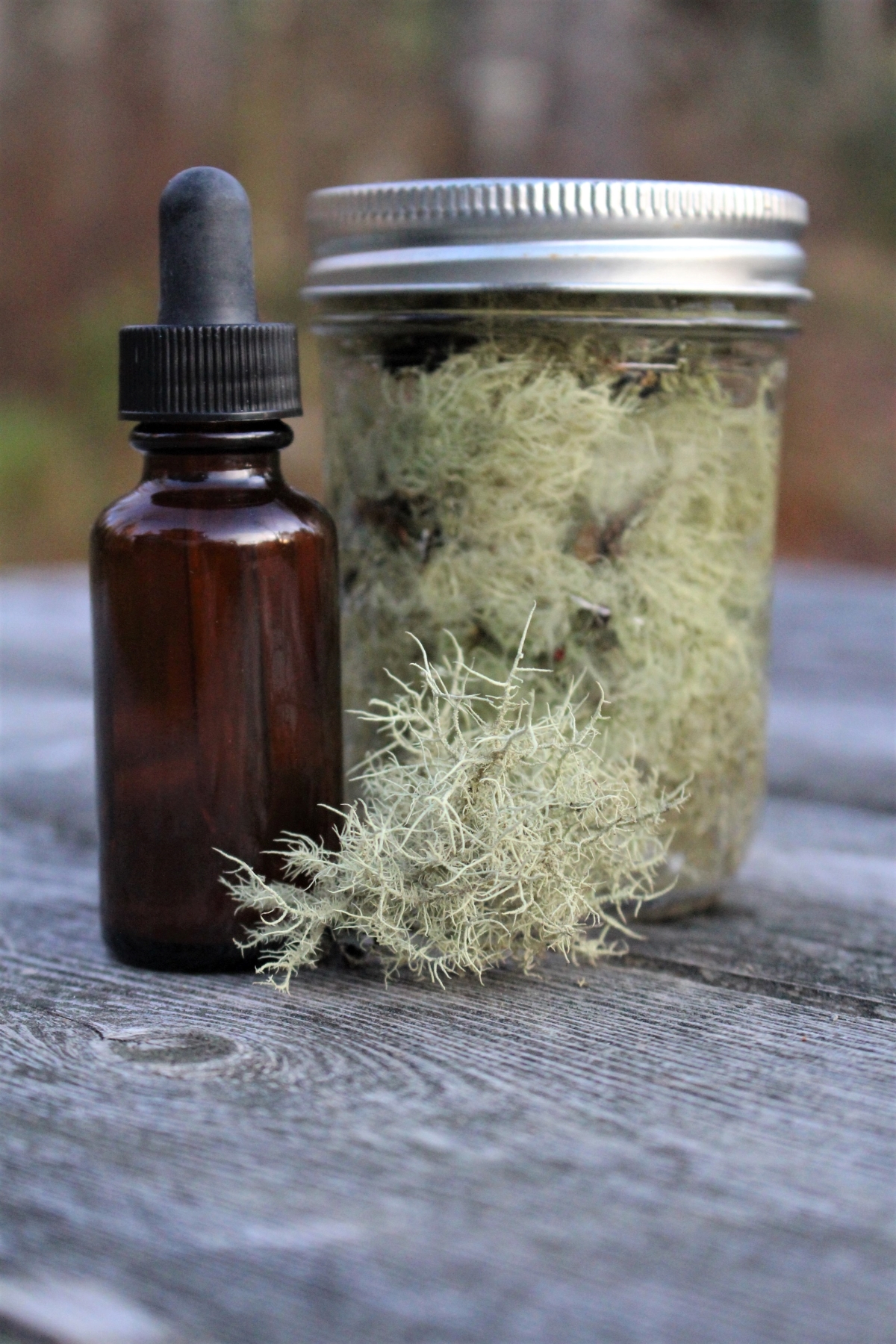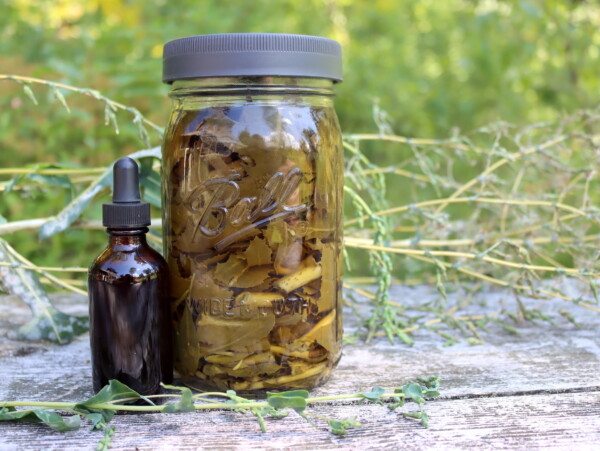Affiliate disclosure: This post may contain affiliate links. Please see our Privacy Policy.
Usnea tincture has been used for thousands of years for its antibacterial, antifungal, antimicrobial, immune-supporting, and wound-healing properties. The name usnea includes several species of lichen from the Usnea family, all of which share similar traits. Whatever ailment or infection you’re dealing with, usnea is a go-to herb to help the body’s immune response conquer illness. It’s also easy to make from just a couple of ingredients so you can keep it on hand for when you need a boost.

Usnea tincture is one of the most effective herbal remedies I’ve used to date, and it’s excellent for treating sore throat and respiratory issues and as a topical antimicrobial.
Usnea is known as “the lungs of the forest,” and both because it lives anchored high in the air in woodlands, and it’s useful for respiratory health.
Usnea is one of the most widely recognized families of lichen.
Historically, people knew these lichens for their potent medicinal properties. It has long been an important herb for treating respiratory infections, UTIs, kidney infections, and skin infections.
Today, we mainly recognize them for their looks. Usnea grows worldwide, forming dangling, branching clusters of gray-green lichen from tree trunks and branches, earning it the moniker “old man’s beard.”
While we love using usnea, it’s essential to harvest respectfully. Usnea species grow extremely slowly, often just 1 millimeter per year, often outliving the trees they grow on. Like many lichens, some usnea species are highly susceptible to air pollution and have seen dramatic declines in parts of their range since the Industrial Revolution.
One of the best ways to harvest usnea is to walk in usnea-filled woods after heavy wind or thunderstorms. Often, you will be able to collect usnea that has naturally broken off and fallen to the ground. You can also harvest it from fallen branches or trees after such storms.
Use caution if you’re new to harvesting usnea. Usnea species can be confused with toxic species like wolf’s bane lichen (Letharia vulpina), which contains toxic vulpinic acid and gets its name from its traditional use as a wolf poison. Always be 100% confident in identifying any lichen you intend to use medicinally.
This guide explains how to identify usnea lichen.

(Always consult your doctor or a clinical herbalist before trying any new herbal remedy, as there’s always the possibility of unintended consequences, allergic reaction, or interactions with other medication. If you’re harvesting wild plant material, make sure you’re 100% confident in your identification and consult multiple sources for your ID. The following is based on my research and experience, but I don’t claim to have any certifications that would qualify me to advise you on your health. Please do your own research and always verify with multiple reputable sources.)
Usnea Tincture Uses
Herbalists use usnea both topically and internally to treat a variety of ailments.
Topically, usnea tincture is used for:
- Cleaning Cuts and Minor Wounds
- Promote Healing in Minor Burns
- Treat Staph Infections of the Skin
Internally, usnea tincture is used to:
- Treat Respiratory Infections
- Boost the Immune System
- Treat Certain Fungal Infections
- Reduce Inflammation
- Treat Gastrointestinal Infections and Wounds like Ulcers
Additionally, the herb is currently being investigated for its potential:
- Anti-Cancer Properties
In these cases, research is ongoing, and more work is needed to establish whether or not the benefits are scientifically significant.

Benefits of Usnea Tincture
Usnea has a long history of use as an antimicrobial agent. Native Americans, Ancient Greeks, practitioners of Chinese traditional medicine, and a traveling group of traditional Bolivian indigenous healers called the Kallawaya have all used usnea for infections, including respiratory, urinary tract, kidney, and digestive infections.
Modern research has supported many of these uses. One usnea lichen was tested for its antimicrobial and antioxidant activities in 2013. Researchers found that the lichen had significant antimicrobial properties and was effective at inhibiting the growth of Staphylococcus aureus bacteria, which causes respiratory and skin infections commonly known as staph infections. It was also effective against Cryptococcus neoformans fungus, which often causes fungal respiratory infections in immunocompromised patients.
Much of usnea’s benefits may come from the compound usnic acid. Researchers have found that usnic acid displays antimicrobial activity against gram-positive bacteria, including Staphylococcus aureus, Enterococcus faecalis, and Enterococcus faecium.
Researchers believe usnic acid may also help with gastrointestinal issues like ulcers. A 2016 study on rats showed that in combination with probiotics, usnic acid could reduce the severity of stomach ulcers.
Usnic acid may effectively promote healing externally as well. In a 2018 study on rats, the rats receiving the topical application of usnic acid to wound sites showed decreased inflammation and improved wound healing compared with rats receiving a placebo. Additionally, a 2019 study found that usnea has good potential for creating films for the treatment and healing of burns.
The antioxidants in usnea may also play a larger role in helping prevent cancer. Usnea contains a type of powerful antioxidants known as polyphenols. Research has shown that polyphenols display anticancer activity against breast, colorectal, and prostate cancers. Further, a 2016 study found usnic acid showed cytotoxic activity against tumor cells in rats and mice.
Don’t consume large quantities of usnea tincture. Usnea tincture is not suitable for prolonged use. High quantities of usnic acid, the compound in usnea, have been shown to cause liver failure.
The doses for usnea tincture vary depending on the intended use and body size. Generally, herbalists recommend taking one to two dropper fulls of usnea tincture two to four times per day while fighting an infection. You can also spray or dab it onto minor skin wounds and infections with a cotton ball or clean piece of cloth.
Parts Used for Tincture
Usnea tincture is simple to make because you use the entire lichen body. Just gently brush off any dirt and debris and remove any bark from where your usnea was attached to the tree.
If you can’t find usnea growing readily near you, you can order it online. Try to find a reputable source that harvests their herbs sustainably. We like the Mountain Rose Herbs dried usnea.
If you have harvested large pieces of usnea, you may want to break or chop it up before tincturing. This will help it fit into the jar and absorb alcohol more efficiently.
How to Make Usnea Tincture
To make a usnea tincture, you’ll need the following ingredients and equipment:
- Fresh or dried usnea
- Vodka* or your favorite alcohol that’s at least 80 proof/40 percent — there’s no need to splurge here; I always use Smirnoff because it’s inexpensive and has a neutral taste**
- One-pint mason jar with an airtight lid (amber glass is ideal, but as long as you keep the tincture away from light at all times, it won’t make a difference)
- Funnel
- Cheesecloth
- Fine mesh sieve
- Amber glass tincture bottles (with dropper)
*The Herbal Academy’s tincture-making course specifically recommends using 40 to 60% alcohol when working with dried herbs and 70 to 95% alcohol when working with fresh herbs.
**Never use isopropyl/rubbing alcohol for tinctures (or any other remedy you plan on ingesting). Even in small amounts, this type of alcohol is toxic and meant for external applications only.

Fill your clean mason jar about ½ full with usnea and cover the usnea, so that it’s all submerged, with the alcohol of your choice. Seal the jar with an airtight lid.
Place your jar somewhere cool and dark. Keep it out of direct sunlight, but take it out to gently shake it once per day. This helps with the tincturing process, but it will be okay if you forget for a couple of days. Tinctures are forgiving.

Maintain this process for about 4 to 6 weeks. Then, you can decant your tincture.
Strain the usnea out through cheesecloth and a funnel or a fine mesh sieve. Squeeze any of the liquid you can out of the usnea.
Bottle your usnea tincture in amber glass tincture or small spray bottles. Label the bottles with the name, date, and dosage. I usually use masking tape and a marker for this.

Usnea Tincture Dosage
For an exact dosage specific to your body and needs, I’d suggest consulting a clinical herbalist.
Generally, the dosage for motherwort tincture is 1 to 2 droppers full, taken 2 to 3 times per day or as needed for up to one week at a time. You can also spray or dab it on to treat external wounds or irritations.
Usnic acid, a compound in usnea, can be tough on the liver. High quantities of usnea tincture or prolonged use could cause liver failure.
Usnea Formulations
Usnea is often combined with other herbs that will help boost the immune system and fight off infections. Good options include echinacea tincture and elderberry tincture. If you’re dealing with a painful condition, you can also try pairing it with analgesic herbs like spilanthes or soothing pain-relievers like valerian tincture.
If you’re interested in the science behind combining herbs to enhance their effectiveness, I’d recommend taking this online course in Mastering Herbal Formulations from the Herbal Academy. It covers the science of blending herbs into homemade formulations in detail.

Usnea Tincture
Equipment
Ingredients
- Usnea Lichen
- Neutral Spirit such as vodka*
Instructions
- Fill a clean, empty mason jar 3/4 full of fresh usnea, or 1/2 full of dried usnea. (Dried usnea is often available from herbal supply shops.)
- Cover the fresh or dried usnea with alcohol, making sure the contents of the jar are completely covered.
- Screw the lid on tightly and gently shake the contents of the jar. Place in a cool, dry location away from light, allowing the extraction to occur over the next 6 to 8 weeks.
- Give the contents of the jar a gentle shake every couple of days.
- Keep an eye on the alcohol level, adding more alcohol to cover the plant material if needed.
- Once the tincture is ready to be decanted, line a funnel with cheesecloth and place the tip of the funnel into the neck of a dark amber glass bottle. Pour the solvent and the usnea into the cheesecloth-lined funnel, pressing to make sure all of the liquid makes it into the bottle.
- Label the tincture with its contents, date of production, recommended dosages, and suggested usages. Store in a cool, dry area away from light.
Notes
Disclaimer on Homemade Herbal Remedies
I’ve been foraging wild medicines and treating my family with herbal remedies for the past 20 years, but I’m self-taught. Be aware that I am not a clinical herbalist, and this is based on my own research and personal experience using medicinal plants. I do not claim to have the experience that’d qualify me to advise you on your health, and I’m only providing this as a reference to encourage a broader interest in medicinal plants.
Please use this as a jumping-off point, but always do your own research and verify anything you read with multiple sources.
It’s always possible to have an adverse reaction to any medicinal herb, and plenty of people are allergic to even gentle herbs like chamomile. Always consult your doctor or a certified herbalist before trying any new medicinal plant. Often, they can have unintended reactions in combination with other herbs and supplements, and many herbs have side effects even when they are effective for their intended purpose.
If you are seriously interested in herbal medicine, I’d suggest investing in a course in herbal medicine, and I’d recommend any of the online courses put out by the Herbal Academy of New England. Specifically, the introduction to herbal medicine course and the family herbalist group of courses.
They also have a mushroom course, covering both medicinal and edible mushrooms, and a Botany and Wildcrafting Course. I’ve taken both and they’re informative, inspiring, and artfully presented.
Herbal Tinctures
Interested in making other homemade herbal tinctures?
- Yarrow Tincture
- Chickweed Tincture
- Elderberry Tincture
- Dandelion Tincture
- Burdock Tincture
- Echinacea Tincture
Herbal Medicine Making
Herbal medicines don’t stop at tinctures! Learn how to make more homemade medicine…





Wow, I just found two bottles of Usnea, one in vodka and one in olive oil in the back of the dried herbs cupboard. It is likely one or two years old. I picked it and started the preserving after a hike in our woods and found the Usnea. The Usnea is still in the bottles and it looks clear and not mouldy.
Will it still be usable do you think? I will need to strain it out before using it.
If tightly sealed (so alcohol wasn’t evaporating), the one in vodka should be fine. Olive oil starts to go rancid around 2 years old, so the one in olive oil likely isn’t still good.
Personally, I’d probably keep the vodka and toss the olive oil one.